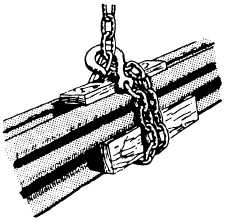If an inspection discloses any unsatisfactory
conditions in a line, see that the line is destroyed or cut
into small pieces as soon as possible. This precaution
prevents the defective line from being used for hoisting.
CHAIN
In the NCF, never use a chain when it is possible to
use wire rope. The reason for this is because, unlike wire
rope, chain does not have reserve strength and does not
give any warning that it is about to fail; therefore, you
will not be alerted of a potentially hazardous condition.
Chain is better suited than wire rope for some jobs
because it is more resistant to abrasion, corrosion, and
heat. When chain is used as a sling, it has no flexibility
and grips the load well.
CHAIN GRADES
It is difficult to determine the grade of some types
of chains by looking at them. Most chains used by the
NCF are class A chain. If you are uncertain of the class
or size of a chain, ask your supervisor.
CHAIN STRENGTH
Before lifting with a chain, make sure the chain is
free from twists and kinks. A twisted or kinked chain
placed under stress could fail even when handling a light
load. Additionally, ensure that the load is properly seated
in the hook (not on the point) and that the chain is free
from nicks or other damage. Avoid sudden jerks in
lifting and lowering the load, and always consider the
angle of lift with a sling chain bridle.
The strength of any chain will be affected when it
has been knotted, overloaded, or heated to temperatures
above 500°F.
HANDLING AND CARE OF CHAIN
When hoisting heavy metal objects using chain for
slings, you should insert padding around the sharp
corners of the load to protect the chain links from being
cut.
Store chains in a clean, dry place where they will
not be exposed to the weather. Before storage, apply a
light coat of lubricant to prevent rust.
Do NOT perform makeshift repairs, such as
fastening links of a chain together with bolts or wire.
When links become worn or damaged, cut them out of
the chain, then fasten the two nearby links together with
a connecting link. After the connecting link is closed,
welding makes it as strong as the other links. For cutting
small-sized chain links, use bolt cutters. To cut
large-sized links, use a hacksaw.
Inspect the chain to ensure it is maintained in a safe,
operating condition. A chain used continuously for
heavy loading should be inspected frequently. Chain is
less reliable than manila or wire rope slings because the
links may crystallize and snap without warning.
Examine the chain closely link by link and look for
stretch, wear, distortion, cracks, nicks, and gouges. Wear
will usually be at the ends of the links where joining
links rub together. If you find wear, lift each link and
measure its cross section.
NOTE: Remove chains from service when any link
shows wear more than 25 percent of the thickness of the
metal.
Replace any link that shows cracks, distortion,
nicks, or cuts; however, if a chain shows stretching or
distortion of more than 5 percent in a five-link section,
discard and destroy the entire chain.
Remove chains from service when links show any
signs of binding at the juncture points of the links. This
condition indicates collapse in the sides of the links has
occurred as a result of stretching.
Before lifting with a chain, first place dunnage
between the chain and the load to provide a gripping
surface. For hoisting heavy metal objects with a chain,
always use chafing gear around the sharp corners on the
load to protect the chain links from being cut. As chafing
gear, use either planks or heavy fabric. In handling rails
or a number of lengths of pipe, make a round turn and
place the hook around the chain, as shown in
figure 13-29.
Figure 13-29.—Chain sling.
13-15

